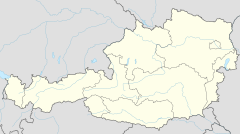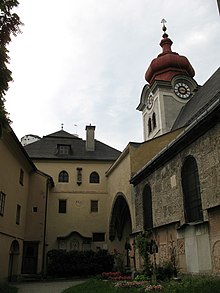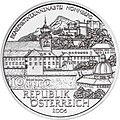Nonnberg Abbey
| Nonnberg Abbey | |
|---|---|
 Nonnberg Abbey, view from Kapuzinerberg | |
| Religion | |
| Affiliation | Catholic Church |
| Ecclesiastical or organizational status | Active |
| Year consecrated | 714 |
| Status | Convent |
| Location | |
| Location | Salzburg, Austria |
| State | Salzburg |
 Shown within Austria | |
| Sector | St. John's Chapel |
| Geographic coordinates | 47°47′46″N 13°03′06″E / 47.79611°N 13.05167°ECoordinates: 47°47′46″N 13°03′06″E / 47.79611°N 13.05167°E |
| Architecture | |
| Type | Monastery |
| Style | Romanesque, Gothic |
| Founder | Saint Rupert of Salzburg |
Nonnberg Abbey (German: Stift Nonnberg) is a Benedictine monastery in Salzburg, Austria.[1] Founded c. 712/715 by Saint Rupert of Salzburg, it is the oldest continuously existing nunnery in the German-speaking world. The monastery complex is today a protected monument and part of the Historic Centre of the City of Salzburg, a UNESCO World Heritage Site since 1996.
History[]

The convent was established beneath the Festungsberg hill and the ruined fortifications of the former Roman city of Juvavum. Its first abbess was Saint Erentrudis of Salzburg, who was either a niece or a sister of Bishop Rupert. The abbey's endowment was provided by the Agilolfing duke Theodo of Bavaria and his successor Theodbert.
The nuns, all of noble birth, held extended estates up the Salzach river in the south of the city. The convent's possessions were later augmented by Emperor Henry II, who was also Duke of Bavaria. The Benedictine rule was finally implemented under Archbishop Conrad I of Salzburg in the early 12th century.
The abbey became independent of the founding house from 987. After a blaze about 1006, the abbey church was re-built with the support of Henry II; he and his consort Cunigunde of Luxembourg attended the consecration in 1009. This Romanesque building was again largely destroyed in a fire of 1423. Reconstruction took place between 1464 and 1509. In 1624 the church was enlarged by the addition of three side chapels. A refurbishment in the Baroque style took place in the 1880s.
Commemorative coin[]
| hide Hohensalzburg Fortress | |||||||||||||||||||||||||||||||||||||||||||||||||
|---|---|---|---|---|---|---|---|---|---|---|---|---|---|---|---|---|---|---|---|---|---|---|---|---|---|---|---|---|---|---|---|---|---|---|---|---|---|---|---|---|---|---|---|---|---|---|---|---|---|
| |||||||||||||||||||||||||||||||||||||||||||||||||
The Abbey was selected as main motif for the Austrian Nonnberg Abbey commemorative coin minted on April 5, 2006. This was the first coin of the series "Great Abbeys of Austria". It shows the Benedictine convent of Nonnberg Abbey. On the hilltop in the background, Hohensalzburg Fortress and the Kajetaner church can be seen. The abbey and fortress are connected by the Reisszug, one of the world's oldest extant railways.
In popular culture[]
Through Maria Augusta Kutschera, later Maria Augusta von Trapp, who became a postulant in the abbey in 1924 and whose life was the basis for the Broadway musical (1959) and film (1965) The Sound of Music, the abbey has acquired international fame. The Mother Abbess during Maria's time at Nonnberg was Sister Virgilia Lütz (1869-1949). Nonnberg Abbey is featured in movies depicting the life of Maria Augusta Kutschera, namely The Sound of Music and Die Trapp-Familie.
Gallery[]

Euro gold and silver commemorative coin

The wooden Gothic altar in the St. John's Chapel by the sculptor Veit Stoss

Pillars inside the St. John's Chapel in Nonnberg Abbey

The entrance door to the St. John's Chapel in Nonnberg Abbey which is open to the public

The road to the gate of Nonnberg Abbey

The entrance gate of the Nonnberg Abbey which is open to the public
References[]
- Citations
- ^ Smith, Christine; Cyrus, Cynthia J. "Nonnberg Abbey". Monastic Matrix. Retrieved 4 February 2013.
- Bibliography
- Franz Esterl: Chronik des adeligen Benediktiner-Frauen-Stiftes Nonnberg in Salzburg, Salzburg, 1841 (at Google Books, in German)
External links[]
- www.nonnberg.at Official Website
- Nonnberg Abbey at Sacred Destinations
- Stift Nonnberg at Visit-Salzburg
- Historic Centre of the City of Salzburg at UNESCO
- Benedictine monasteries in Austria
- Christian monasteries established in the 8th century
- Benedictine nunneries in Austria
- Monasteries in Salzburg
- Tourist attractions in Salzburg
- Churches completed in 714






